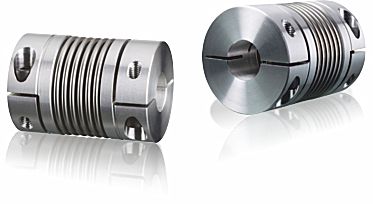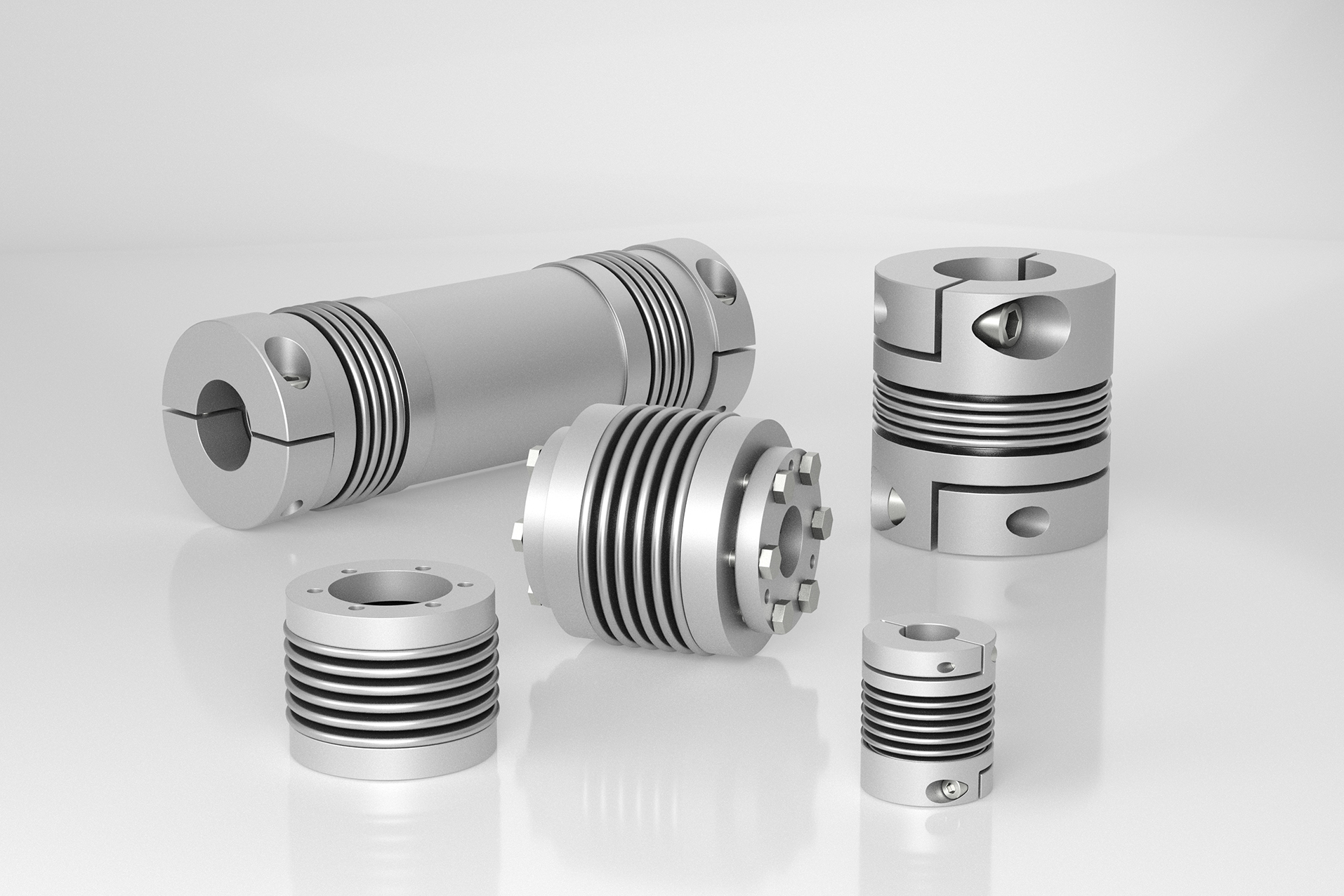Product Description
GRC Aluminum alloy bellows clamping coupling
Description of GRC Aluminum alloy bellows clamping coupling
>The material is aluminum alloy, and the middle bellows is made of stainless steel with excellent corrosion resistance
>Laser welding is used between bellows and shaft sleeve, with zero rotation clearance, suitable for CHINAMFG and reverse rotation
>Bellows structure can effectively compensate radial, angular and axial deviation
>Designed for servo motor stepper motor
>Fastening method of clamping screw
Dimensions of GRC Aluminum alloy bellows clamping coupling
| model parameter | common bore diameter d1,d2 | ΦD | L | L1 | L2 | L3 | N | F | M | tightening screw torque (N.M) |
| GRC-16×27 | 4,5,6,6.35,7,8 | 16 | 27 | 7.5 | 2 | 8 | 13.5 | 3 | M2.5 | 1 |
| GRC-20×32 | 5,6,6.35,7,8,9,9.525,10 | 20 | 32 | 7.2 | 2.8 | 12 | 18 | 3.5 | M3 | 1.5 |
| GRC-22.5×34 | 5,6,6.35,7,8,9,9.525,10,11,12 | 22.5 | 34 | 8.05 | 2.8 | 12.3 | 20.2 | 4.5 | M3 | 1.5 |
| GRC-25×37 | 6,6.35,7,8,9,9,9.525,10,12 | 25 | 37 | 9.5 | 3 | 12 | 20.2 | 4.5 | M3 | 1.5 |
| GRC-32×42 | 8,9,9.525,10,11,12,12.7,14,15 | 32 | 42 | 8 | 4 | 18 | 27.2 | 5.5 | M4 | 2.5 |
| GRC-40×55 | 8,9,9.525,10,11,12,12.7,14,15,16,17,18,19,20 | 40 | 55 | 11.5 | 6 | 20 | 34.5 | 6.5 | M5 | 7 |
| GRC-55×72 | 10,11,12,12.7,14,15,16,17,18,19,20,22,24,25 | 55 | 72 | 16.5 | 6 | 27 | 51.9 | 10 | M6 | 12 |
| GRC-65×81 | 10,11,12,12.7,14,15,16,17,18,19,20,22,24,25,28,30,32,35,38 | 65 | 81 | 19.5 | 7 | 28 | 60.5 | 10.5 | M6 | 12 |
| model parameter | Rated torque (N.M)* |
allowable eccentricity (mm)* |
allowable deflection angle (°)* |
allowable axial deviation (mm)* |
maximum speed rpm |
static torsional stiffness (N.M/rad) |
moment of inertia (Kg.M2) |
Material of shaft sleeve | surface treatment | weight (g) |
| GRC-16×27 | 0.8 | 0.1 | 1.5 | + 0.4 -1.2 | 9400 | 150 | 8.0×10-7 | High strength aluminum alloy | Anodizing treatment | 8 |
| GRC-20×32 | 1.5 | 0.15 | 2 | + 0.6 -1.8 | 7600 | 220 | 2.2×10-6 | 13 | ||
| GRC-22.5×34 | 1.8 | 0.15 | 2 | + 0.6 -1.8 | 6000 | 300 | 6.5×10-6 | 22 | ||
| GRC-25×37 | 2.0 | 0.15 | 2 | + 0.8 -1.8 | 6100 | 330 | 6.9×10-6 | 30 | ||
| GRC-32×42 | 2.5 | 0.2 | 2 | + 0.8 -2.5 | 4700 | 490 | 2.1×10-5 | 53 | ||
| GRC-40×55 | 6.4 | 0.2 | 2 | + 0.8 -2.5 | 4200 | 530 | 2.3×10-5 | 97 | ||
| GRC-55×72 | 12 | 0.2 | 2 | + 0.8 -2.5 | 3900 | 860 | 3.7×10-5 | 200 | ||
| GRC-65×81 | 18 | 0.2 | 2 | + 0.7 -2.5 | 3500 | 900 | 3.6×10-5 | 380 |
/* January 22, 2571 19:08:37 */!function(){function s(e,r){var a,o={};try{e&&e.split(“,”).forEach(function(e,t){e&&(a=e.match(/(.*?):(.*)$/))&&1

How Do Bellows Couplings Contribute to Reducing Vibrations and Ensuring Smooth Operation?
Bellows couplings play a crucial role in reducing vibrations and ensuring smooth operation in mechanical power transmission systems. They achieve this through their unique design and material characteristics, which allow them to absorb and dampen vibrations effectively. Here’s how bellows couplings contribute to minimizing vibrations and promoting smooth operation:
- Flexible Bellows Design: Bellows couplings feature a thin-walled, accordion-like structure known as the bellows. This design provides flexibility in multiple directions, allowing the coupling to compensate for minor misalignments and shaft movements. The bellows’ flexing action absorbs shocks and vibrations, preventing them from propagating through the system and reducing the transmission of vibration to connected equipment.
- Vibration Damping: The flexible bellows act as a vibration damper, absorbing and dissipating vibrational energy generated during the operation. When the system experiences dynamic forces or sudden shocks, the bellows expand and contract to absorb these forces, preventing them from resonating throughout the system. This damping action helps maintain the stability of the machinery and prevents excessive wear and tear on components.
- No Mechanical Contact: Unlike some coupling types that rely on friction or mechanical contact, bellows couplings transmit torque through pure flexure without any metal-to-metal contact. This feature eliminates backlash and torsional wind-up, further reducing vibration and ensuring smoother operation. As a result, bellows couplings are well-suited for applications requiring high precision and minimal vibration-induced errors.
- High Torsional Stiffness: While bellows couplings are designed to be flexible, they still possess high torsional stiffness. This stiffness ensures accurate torque transmission without any loss, contributing to the overall efficiency and smoothness of the system’s operation.
- Resonance Avoidance: Bellows couplings are designed to have specific critical speeds and resonant frequencies that prevent resonance from occurring within the coupling itself. Resonance can lead to severe vibration amplification, which can be detrimental to the equipment and surrounding components. The careful design of bellows couplings helps avoid such resonance issues.
By effectively dampening vibrations, absorbing shocks, and providing torsional stiffness, bellows couplings contribute to smoother operation, reduced mechanical wear, and increased overall system reliability. Their ability to handle misalignments and their high torsional stiffness make them a popular choice in precision motion control systems, robotics, and various industrial applications where smooth and accurate performance is essential.

How do bellows couplings ensure torque transmission and minimize backlash in precision systems?
Bellows couplings are used in precision systems to transmit torque between two shafts while minimizing backlash, which is crucial for maintaining accurate positioning and reducing vibrations. Here’s how they achieve these functions:
- Torsional Rigidity: Bellows couplings are designed with a series of flexible metal convolutions (bellows) that allow angular misalignment between the shafts. The metal bellows provide high torsional rigidity, ensuring efficient torque transmission from one shaft to the other with minimal power loss.
- Backlash Elimination: Backlash is the play or movement that occurs when reversing the direction of rotation in a mechanical system. Bellows couplings are ideal for precision applications because they have virtually zero backlash. The absence of backlash helps maintain accurate positioning and prevents undesired movements in precision machinery.
- Compensation for Misalignment: In precision systems, shaft misalignments can occur due to manufacturing tolerances, thermal expansion, or other factors. Bellows couplings can accommodate angular, axial, and parallel misalignments, ensuring smooth operation and preventing excessive stress on the shafts and connected components.
- Vibration Damping: The flexible nature of bellows couplings also provides some level of vibration damping. This feature helps reduce vibrations and shocks in the system, which is especially important in sensitive precision equipment to maintain stability and accuracy.
- Compact Design: Bellows couplings are compact and lightweight compared to some other coupling types, making them suitable for applications where space and weight restrictions are important considerations.
In summary, bellows couplings play a crucial role in precision systems by ensuring efficient torque transmission, minimizing backlash, compensating for misalignments, dampening vibrations, and providing a compact design. These features make them an excellent choice for high-precision machinery and applications where accuracy and reliability are paramount.

How do Bellows Couplings Accommodate Misalignment and Axial Motion between Shafts?
Bellows couplings are designed to accommodate misalignment and axial motion between shafts while maintaining accurate torque transmission. The key features that enable this flexibility are the bellows element and the coupling’s construction.
1. Bellows Element: The bellows element is a thin-walled, corrugated metal tube with deep convolutions. When torque is applied to the coupling, the bellows element flexes, allowing for angular misalignment between the driving and driven shafts. The corrugations in the bellows provide the necessary flexibility while maintaining the overall structural integrity of the coupling.
2. Axial Motion Compensation: Bellows couplings can also accommodate axial motion between shafts. When there is axial displacement, the bellows compresses or extends, effectively compensating for the relative movement of the shafts along the axial direction. This feature is particularly beneficial in applications where shafts experience thermal expansion or contraction during operation.
3. Single and Multi-Bellows Designs: Bellows couplings are available in both single and multi-bellows designs. Single-bellows couplings offer greater flexibility and are suitable for applications with relatively low misalignments and axial motion. On the other hand, multi-bellows couplings provide enhanced flexibility and can accommodate higher levels of misalignment and axial motion.
4. Zero Backlash: Bellows couplings are designed to have minimal or zero backlash. Backlash refers to the play or clearance between the coupling’s components. Zero backlash ensures that there is no lost motion when reversing the direction of rotation, making bellows couplings ideal for precision motion control applications.
5. Reducing Side Loads: To ensure optimal performance and longevity, it is essential to minimize side loads on bellows couplings. Excessive side loads can cause premature wear and fatigue in the bellows element, leading to reduced coupling life.
Overall, bellows couplings provide excellent flexibility and compensatory capabilities, making them a preferred choice in applications where misalignment and axial motion are expected. The ability to handle these factors without compromising torque transmission or introducing backlash makes bellows couplings suitable for various industries, including robotics, automation, aerospace, and semiconductor manufacturing.


editor by CX 2024-03-03
